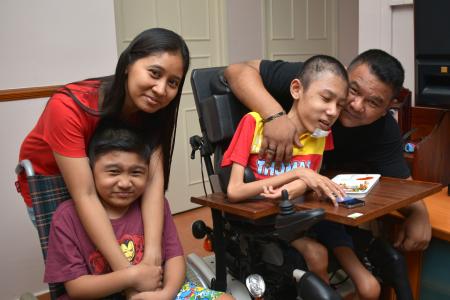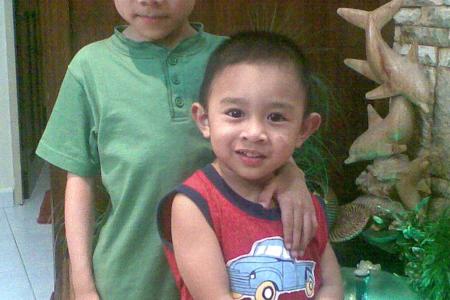Mum's dread over deadly disease: 'I fear the end is near'
Mother of two boys with rare muscular disorder has seen her two siblings die of same disease in their teens
Her life has been one of ceaseless dread and despair.
At 37, Madam Rosidah Omar has seen two of her brothers die in their teens.
Now she has to grapple with the gut-wrenching reality that her two sons are likely to die before they reach 21.
All because of a disease called Duchenne Muscular Dystrophy (DMD).
Her two brothers died of the disease at ages 14 and 16. Now her sons, aged 10 and 15, have been crippled by DMD, leaving them in wheelchairs.
DMD is a genetic disorder that causes the sufferer's muscles to deteriorate over time.
Eventually the vital organs stop functioning. (See report, far right.)
Madam Rosidah and her mother were found to be carriers of the disease.
The eldest of five children, Madam Rosidah became familiar with DMD when her eldest brother, Mohd Rizal Omar, died at the age of 14.
The childcare centre teacher told The New Paper she remembers how the condition gradually robbed her brother of his mobility.
"He could walk at first, even run. But after a while, I noticed he couldn't run as fast. He then started gripping his legs a lot while he walked and eventually, he started tripping all the time.
"That's when we knew he probably wasn't going to walk again. At first we thought it was just some physical disability that showed up late.
"We didn't know then that it would eventually kill him."
Madam Rosidah's sister and brother, Ms Rosifah Omar, 28, and Mr Muhd Rizam Omar, 25,did not seem to be affected.
But just when she thought their days of dealing with DMD were over, her youngest brother, Muhd Raif Omar, began showing symptoms of DMD soon after her eldest brother died.
He was then only eight years old.
A few years later, Madam Rosidah gave birth to her first son, Mohd Sufyan Sohaimi.
He was a year old when doctors detected a problem with his muscle structure. He was diagnosed with DMD.
Alarmed, she took her family members - her mother and her siblings - for a blood test.
"It was then that I discovered that my mother and I were carriers. My other two (middle) siblings were fine."
Being a carrier meant that her sons were likely have the condition. The disorder affects only boys. Despite that, she wanted to try and have another child.
"I thought that if (the disease) skipped my middle brother, then maybe there would be a chance my second child would be safe."
In 2005, Madam Rosidah gave birth to a baby boy, Muhd Danial Sohaimi.
Doctors told her that he was healthy.
"I was overjoyed. I truly believed that I was finally blessed."
WORST YEAR OF HER LIFE
But Madam Rosidah would soon experience what she recalls as the worst year of her life.
In 2012, when Danial turned seven, he began having difficulty walking.
"I couldn't understand why this was happening again. He was supposed to be healthy. I didn't want to believe it."
Madam Rosidah's husband, Mr Sohami Wari, 40, a senior technician, said: "It was so difficult for us. We were so hopeful that he would be able to lead a normal life.
"We didn't want to confirm what we already knew, but we knew we had to."
Madam Rosidah's youngest brother eventually died in 2012 at the age of 16.
When The New Paper visited the family at their four-room HDB flat in Sembawang Close, Muhd Danial, 10, was playing video games.
The Canberra Primary School pupil proudly showed how he could operate his wheelchair on his own.
Elder brother Mohd Sufyan, 15, who goes to Rainbow Centre - Yishun Park, enjoys watching videos and being photographed.
He uses an automated wheelchair and has limited use of his arms and hands. He needs help going to the toilet, taking a bath and eating.
A maid helps look after the boys when Madam Rosidah is at work.
Both sons sleep with their mother at night on the same bed.
Sufyan wakes up at hourly intervals to ask his mother to help him shift his sleeping position.
"It gets exhausting sometimes when I have to wake up at 6am and I'm unable to have proper sleep," she said.
Madam Rosidah added that getting around is also difficult as she has to use a special bus service that can accommodate motorised wheelchairs. The bus service costs $120 for a return trip from any location.
Now, they leave home only on special occasions like Hari Raya Aidilfitri and when they go to for their annual medical check-up.
"Every time we go for a check-up, I'm told only bad news," she said.
"I know how this story ends, so when I see them enjoying themselves, it hurts knowing there's nothing I can do to help them."
When the children ask her about their condition, she tells them they have an illness.
"If they ever ask me what happens to them in the future, then I'll know they are mature enough to deal with what will probably happen to them," she said.
For now, she wants to share her story to show "how DMD can affect the lives of people".
"I thought that if (the disease) skipped my middle brother, then maybe there would be a chance my second child would be safe."
- Madam Rosidah Omar on why she tried for a second child
"I know how this story ends, so when I see them enjoying themselves, it hurts knowing there's nothing I can do to help them."
- Madam Rosidah Omar, on her boys suffering from the same disease that killed two of her brothers when they were in their teens
Disorder affects only boys
Duchenne Muscular Dystrophy (DMD) is a genetic disorder that slowly destroys the body's muscles.
It is caused by an absence of dystrophin, a protein that helps to keep muscle cells intact.
The absence of dystrophin is in turn caused by a mutation in the X chromosome.
Without the protein, the muscles degenerate, causing progressive weakness and loss of muscle mass.
"Girls, having two X chromosomes, don't get the disorder because the normal X chromosome is able to compensate for the mutated one," Dr Charles Siow, a consultant neurologist at Siow Neurology, told The New Paper.
"Boys, however, only have one X chromosome and so are unable to overcome it."
Worldwide, DMD affects one in 3,500 live male births, said Dr Josiah Chai, senior consultant at the department of neurology at the National Neuroscience Institute.
Previously, affected boys were expected to live only to their 20s.
But with advances in medical technology, patients can now live to their 30s.
There is still no known cure.
"We recognise that they have a short-term life span, so we tend to focus on helping families cope with it," said Ms Sherena Loh, executive director of the Muscular Dystrophy Association (MDA) of Singapore.
The MDA is a self-help organisation that aims to provide care and support to people with muscular dystrophy.
Ms Loh said: "DMD is the most common and severe form of muscle dystrophy, with 45 per cent of our 120 beneficiaries having it.
"We hope that we can raise awareness of the condition, so that affected families won't have to feel that they're alone."
Get The New Paper on your phone with the free TNP app. Download from the Apple App Store or Google Play Store now



